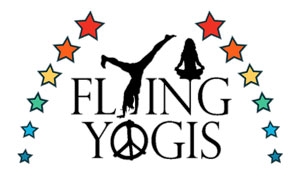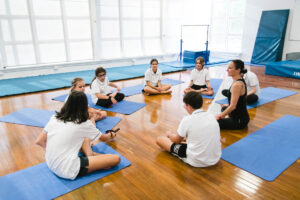
Flying Yogis
Yoga & Acrobatics for Kids
Week 4 OUTLINE
HERE IS A GUIDE ON HOW TO STRUCTURE YOUR YAMAS LESSON.
CLASS INTRO (15 MINS)
ACTIVITY 1: LINKED TO SOCIAL TOPIC (15 MINS)
ACTIVITY 2: LINKED TO PHYSICAL TOPIC (15 MINS)
CONCLUSION AND MEDITATION (10 MINS)
THIS WEEKS SOCIAL FOCUS IS : Perception and perspective
THIS WEEKS PHYSICAL FOCUS IS : Strength and balance in my body
1. CLASS INTRO - 15 MINS
A. WELCOME CLASS AND INTRO TO TOPIC- 5 mins
GET THE GROUP SEATED AND FOCUSED, INTRODUCE YOURSELF AND SESSION RULES.
UNDERSTANDING PERCEPTION AND PERSPECTIVE
Perspective-taking refers to a person’s ability to consider a situation from a different point of view. It requires you to put yourself in the other person’s position and imagine what you would feel, think, or do if you were in that situation. Explain that perspective is point of view: how someone sees a situation, their feelings about a situation and their opinions of a situation.
Why is it a good thing?
When you are able to imagine a situation from someone else’s perspective, you can gain a better understanding of someone else’s motives or change your own behavior so you don’t offend someone.
UNDERSTANDING STRENGTH AND BALANCE IN MY BODY
To get stronger and improve your balance can help in everything you do, from your favourite sport to improving your posture. We should enjoy challenging our bodies to make them as strong as we can be. Strength and balance in our body can make our minds feel strong too!
Questions to start discussions:
Do I feel strong? How can I get stronger? What would it benefit me?
B. COMPLETE JOURNAL OR WORKSHEET- 5 mins
NO LONGER THAN 5 MINS
Stick in and complete necessary worksheet, write thoughts and topic definition (worksheet will say the weeks social skill and the weeks physical skill)

C. Quick 5 pose stretch/warm up:- 5 mins
NO LONGER THAN 5 MINS
(5 new poses or stretches each week) Salutes if desired
2. SOCIAL TOPIC GAME/ ACTIVITY (15 min)
Topic- Perspectives
There are 3 activity options below, select the one best suited to your age group. If you have spare time feel free to complete 2+ activities with your group.
A. GAME #1 EXPLORING THE BIGGER PICTURE
What you need:
Give each student a small piece of a larger picture, which has been cut into pieces. Organize students into small groups of 3–4 students. After groups have been formed, distribute pieces of the photograph to the members of each group.
Challenge kids to understand that scenario from just the part of the image they have.
Description:
1. Have students (draw, act out in roleplay, discuss or explain) what they think the rest of the photo or story may be, without looking at the other pieces. Remind them to focus on their part only.
2. Have the members of each group share their illustrations with one another. Engage students in discussion about the similarities and differences of their illustrations.
3. Ask them to predict what the entire picture might be.
4. Assemble all of the pieces of the picture to reveal the entire image.
After completing the photograph activity, introduce the concept of perspective.
Lesson learnt-
Make connections & provide examples e.g:
Connect to photograph activity, where each student formed a different idea of the original photograph because each was seeing it from a different perspective.
Point out that there are always at least two sides to every story, which is why people go to court and why teachers ask each student involved in a disagreement to tell his/her side
Sum up the explanation of perspective with the analogy of “walking in someone else’s shoes.” .
B. GAME #2 DIFFERENT LIKES AND DISLIKES
What you need:
5 different things to smell
5 different things to feel
Description:
1. Blind fold each child and present them 5 different things to smell. (Different fruits, spices, foods, scratch and sniff stickers etc.)
2. Get the group to discuss how they thought each numbered item smelt (good, bad, neutral)
3. Do the same with 5 different things to touch (soft, hard, rough, sharp, textured, cold, warm etc.)
4. Get the group to discuss how they thought each numbered item smelt (good, bad, neutral)
Lesson learnt-
Discuss how the items neither smelt/felt good or bad they are merely items and it is our perspective and opinion that forces us to form a judgement or perspective
Highlight how we can change our perspective and perception of things by challenging ourselves to change how we think or feel about it.
C.GAME #3 - ILLUSIONS (DO YOU SEE WHAT I SEE)
What you need:
Printed/Laminated Illusions
Description:
Gather a series of illusions. Show the kids and give them a few minutes to decipher what they see. Then show them how it may be perceived by others.
Lesson Learnt
Explain that not everyone sees the same thing all the time and that if we concentrate we can change our perspective to see how others might perceive things. Explain that the way we look at things changes what we see and may feel.

Video guides below if available
3. PHYSICAL SKILL- GAME/ ACTIVITY (15 min)
Topic- Strength and Balance in my Body
There are 3 activity options below, select the one best suited to your age group. If you have spare time feel free to complete 2+ activities with your group.
A. YOGI SAYS - (YK-3)
What you need:
Board/Paper/marker for tallying points
Description:
Split the class into 2 teams. Give all students several strength hold challenges, the student who can hold each pose the longest gets a point for their team. Some examples; (dish hold, superman hold, plank hold, spider handstand hold)
B.GAME #2 BALANCING TREE POSE HOLD
What you need:
Soft pillow basketball/ can also be done with no ball, nudging kids with a small poke
Description:
The students stand in a circle in tree pose balancing.. Challenge them to do it with eyes closed, or while patting their head and rubbing their stomach etc.
Then explain they must remain balancing as you gently tap them on the back with the soft ball. The last remaining balancing wins.
C. GAME #3 BALANCING WITH FRIENDS!
Description:
Must have total strength and balance to do This five-person twist on the human pyramid… It is easier than it looks. Master the pose!!
Then suggest some other balancing and strength related group or partner poses.

Video guides below if available
4. ENDING DISCUSSION & MEDITATION (10 min)
BRING THE GROUP BACK INTO A CENTRAL CIRCLE, DISCUSS ANY LAST IDEAS OR LEARNINGS FROM THE GAMES AND ANSWER ANY LAST QUESTIONS
Ask the kids what they have learnt and how they will carry these skills into the rest of their week
FINISH WITH A NEW MEDITATION EACH WEEK

CANDLE GAZING MEDITATION –
Also known as “trataka” it’s where you keep your eyes open and focus on a small point or object. Frequently a trataka is done with a candle, and your attention is focused on the flame. A candle gazing meditation helps bring energy to the third eye, increases concentration, and improves memory.
Select a level surface for your candle. This needs to be free of flammable materials and near eye level when you are sitting. Place the candle on the surface and light it. Remain completely still while meditating.
Stare at the candle and allow it to be the main focus of your mind. Hold your eyes steady even if you feel distracted or bored. Your eyes may begin to water, but hold steady and the sensation will pass. If you blink or get distracted, just return your attention to the flame.
As you gaze at the candle, breath. Focus on the sensation of the light flowing into you with each inhalation. As time passes, the room around you will fade until your only awareness is the flame.
When your meditation is done, lay down and close your eyes for five minutes. This will allow your mind and body to come back to full awareness before you continue your day.
5. GAME SUGGESTIONS FOR IF YOU HAVE EXTRA TIME
© Copyright - Flying Yogis